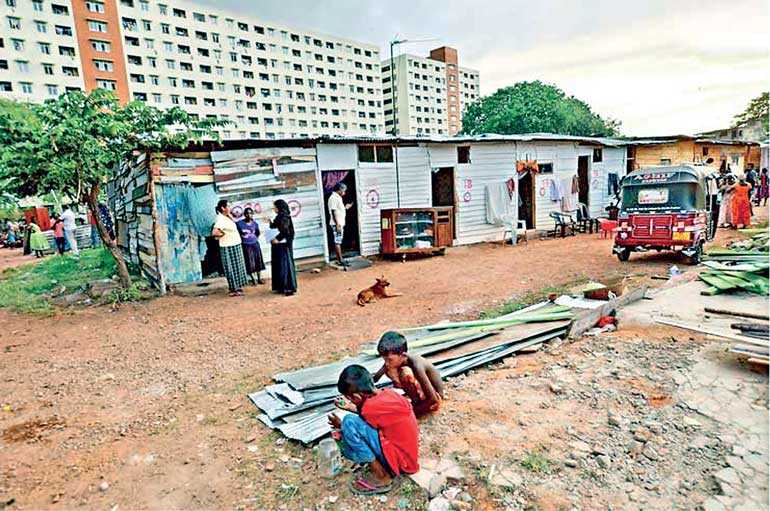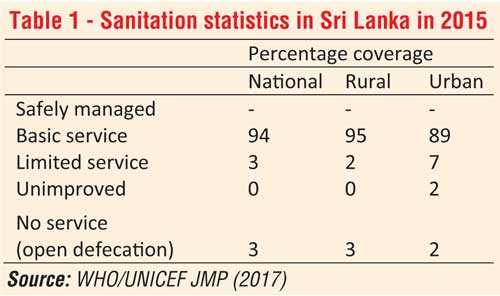Saturday Apr 05, 2025
Saturday Apr 05, 2025
Tuesday, 31 December 2019 01:31 - - {{hitsCtrl.values.hits}}

Inclusive sanitation encompasses the aspects such as safe management of human waste along the whole sanitation service chain, effective resource recovery and re-use embracing a diversity of technological solutions, while including the needs of all stakeholders such as children (considering age appropriateness), differently abled community, girls/females (addressing menstrual hygiene needs, etc.) as well as elderly population in the society. Access for adequate sanitation is a right of every citizen of a country and inclusive strategies reaching the needs of all genders and underprivileged groups should, therefore, be priorities of a sustainable sanitation policy of a nation.
This article examines the current policies, standards, rules, and regulations related to sanitation and the related literature published, to assess the inclusiveness of current sanitation standards and practices in Sri Lanka. The aspects such as the current situation with respect to water and sanitation coverage, availability, and adequacy of legal provisions as well as standards that are in place to protect the rights of all the stakeholders with respect to inclusive sanitation requirements in Sri Lanka are assessed and presented.
Current national policies on sanitation
In Sri Lanka, the governance of water, in general, is the task of several ministries and agencies in respect of over 40 Acts of Parliament. As of today, there are two main policies on water and sanitation in Sri Lanka, adopted by two ministries, i.e. Ministry of Water Supply and Drainage (2017, applicable for both urban & rural areas) and Ministry of Urban Development Construction & Public Utilities - Rural Water Supply & Sanitation Division (2001, appropriate only for rural areas). 
Overview of National Sanitation Policy by Ministry of Water Supply and Drainage (2017)
The National Policy on Sanitation, adopted by the Ministry of Water Supply and Drainage (MWSD) in 2017, is intended to provide guidance to National Water Supply and Drainage Board (NWSDB), provincial councils, local authorities, lending institutions, and organisations involved in delivering water supply and sanitation services.
This national policy is applicable to urban areas as well as the rural areas, inclusive of the estate sector. It should be noted that this policy does not cover aspects such as management of wastewater, solid waste, and animal excreta.
It is commendable to see the key areas identified in the policy that includes all-important aspects pertaining to inclusive sanitation such as development, operation and maintenance of facilities and services, reaching out to people without services, including the marginalised, child-friendly school sanitation care and maintenance with particular attention to needs of females, not limited to facilities for menstrual hygiene, particular considerations on construction of latrines for disabled persons, sanitation facilities in public places and in commercial, industrial, transport, and healthcare sectors, guidance on selection of appropriate technology, maintenance of service levels and quality assurance programs and monitoring and evaluation. Under the legal framework of the policy, it provides guidelines and standards for selection and construction of sanitation facilities as well as penalties for non-compliance.
Overview of National Policy for Rural Water Supply and Sanitation Sector by Ministry of Urban Development, Construction and Public Utilities (2001)
Under this policy, sanitation is considered a personal matter that requires the commitment of each individual as well as the community and probably, therefore, no attention has been paid to inclusive sanitation considerations.
The policy endorses the use of simple technologies manageable at the household and community level to be developed and prompted as cost-effective means of encouraging improved sanitation. In this policy, the basic facility for sanitation has been identified as the ventilated improved pit latrine.
Current sanitation standards and guidelines in Sri Lanka
While policies on sanitation are essential in providing a general directive for improving sanitation practices in the country, standards and guidelines are vital to realise and achieve the set goals. As such, a thorough review was done to investigate the existing standards and guidelines pertaining to inclusive sanitation practices in Sri Lanka.
Assessment of the adequacy of coverage of the inclusive sanitation attributes through the existing sanitation standards and guidelines available as stipulated by laws and regulations applicable to different sectors and stakeholders in Sri Lanka revealed that the majority of the standards and guidelines attempt to address only the inclusive sanitation attribute of ‘safe management of human waste’.
SLS 745: 2004 Part 2, PHI manual (2010), Law No. 41 of 1978 – Section 8 – planning & building regulations by Urban Development Authority, general guidelines for factory buildings (2011) by Board of Investment, Sri Lanka and guidelines for housing development in coastal areas of Sri Lanka (2005) - tsunami disaster housing program by National Housing Development Authority, Ministry of Housing and Construction provide design guidelines with limited technical details, statutory requirements and best practice guides, etc.; comprehensive inclusive sanitation considerations have not been addressed adequately in most of these existing standards and guidelines.
The needs of the differently abled community are covered by an extraordinary gazette notification of 1,467/15, 2006, Act No. 28 of 1996. This gives a comprehensive coverage for setting up facilities (with technical details) in public building, public place where common services are provided. However, there is no provision about the mandatory requirements to support the needs of the differently abled community in their domestic or care home environments. Further, the Ministry of Education provides only the minimum guidelines for the number of sanitary facilities to be made available and lacks details for setting up facilities and inclusive considerations. 
The key areas neglected in most of the standards and guidelines reviewed could be identified as the age/gender appropriateness and considerations for people with special needs, especially in their domestic environments. Further, no standards and guidelines covering the needs of girls/females (menstrual hygiene, etc.) could be found.
Moreover, the majority of the existing standard documents lack the technical specifications (dimensions, etc.) for facility creation, leaving the same to the implementer to interpret. This has led to building of non-standard sanitation facilities minimising the benefits that can be achieved. The implications of such practices can be adverse and far-reaching for the environment, living conditions and human health.
Given the number of individually constructed toilets spread across rural areas of Sri Lanka and the potential variation in their design and construction quality, there is also a possibility of groundwater becoming faecally contaminated.
Statistics on sanitation in Sri Lanka
According to a report by World Health Organization/United Nations International Child Education Fund (2014), while sanitation coverage in Sri Lanka is one of the best in South Asia it needs to improve rural school sanitation, sanitation facilities for the disabled and the problems of groundwater contamination resulting from on-site sanitation in congested townships.
This is further confirmed by the statistics shown in Table 1 (WHO/UNICEF JMP, 2017). Alarmingly, it shows that safely managed sanitation to be absent in Sri Lanka. Nationally, the sanitation coverage has been identified as in basic level to be 94%. It can be seen that 2-3% of the population still regularly use public facilities, if available or practice open defecation.
It is evident that while prevailing standards and guidelines have not been able to elevate the sanitation standards of the country to the highest level due many reasons. Therefore, it is worth to critically analyse the present sanitation practices in all sectors, covering the whole country and analyse the challenges faced by the communities in different social, cultural and geographical setups to identify the specific gaps and needs. Though there is very limited documented evidence to identify the incorporation of the inclusive sanitation considerations in different cross sections of the society, it is essential to explore the possible causes. Domestic sanitation (Urban and rural), school sanitation and sanitation in workplaces and public places can be considered as the most important areas for investigation.
Rural sanitation almost 100% depends on onsite sanitation practices and becomes the sole responsibility of the community. Among many other factors, economic reasons, poor hygienic education, perception, lack of water within a short distance (< 200m), lack of awareness of proper construction methods and sound sanitation technologies and specific site conditions not supportive of onsite disposal techniques (water table being shallow or rocky terrains) can be considered as key factors contributing to lack of adequate sanitary facilities, not only in rural areas but also in some urban and semi-urban areas.
Further, similar factors have led to the exclusion of differently abled family members when planning and designing of household sanitation practices. When compared to the rural population, many urban communities may have a toilet facility within the premises; however, required construction and maintenance standards to achieve satisfactory personal hygiene levels could be a problem. Also, inclusiveness for aged or differently abled family members may not be well addressed in such circumstances.
While middle-income families may have better sanitary facilities meeting the minimum standards, adequate considerations for inclusiveness for differently abled family members and young children may still be an issue. This can be mostly ascertained to the lack of awareness of the existence guidelines (extraordinary gazette notification of 1,467/15, 2006, Act No. 28 of 1996) as well as the availability of hardware that can be used to construct facilities.
Reports have shown that hundreds of schools, including those in the Western province still do not have proper and adequate toilets while 17 schools in the North Central province reported not to have a single toilet. According to the Ministry of Water Supply and Drainage, child-friendly school sanitation with sustainable care and maintenance is to be tenth out of 16 priority areas in a new blueprint that acknowledges school sanitation as a challenge.
According to a survey done by National Water Supply and Drainage Board in 2011, nearly 1,300 out of 9,500 primary and secondary schools (almost one million schoolchildren), and around 180,000 families nationwide, did not have access to a sanitary way of disposing of their faeces. There are practically no “female-friendly toilets” with good waste disposal facilities, soap and water, even in all-female schools. Because of this, female children tend to suffer the most and are compelled to be absent themselves from attending school during menstruation.
Though official statistics are not available, except several private and few government offices and workplaces, there are no standard sanitary facilities for the employees and the customers visiting these places. Most of the time, even the sanitary facilities available lack the required number to minimise waiting time and quality considerations such as regular maintenance of cleanliness, availability of adequate water for flushing and cleaning, adequate inclusiveness for differently able people, female menstruation hygiene, etc.
It should be noted that most of the janitorial service personnel engaged in cleaning such facilities and cities, have been denied access to toilets during the working hours. Further, some of these workers are exposed to risks due to the lack of use of personal safety gear. Most of the public sanitary facilities do not possess required cleanliness, adequate water supply and bins for disposal of used menstrual material.
Way forward
It could be seen that irrespective of the prevailing policies, standards and guidelines on sanitation covering urban, rural, coastal areas, estate sector as well as schools and industrial sectors, Sri Lanka has still not been able to achieve satisfactory levels of inclusive sanitation across all sectors addressing the needs of the elderly and young population as well as gender-specific problems.
Lack of readily implementable sanitation solutions, suitable for different sectors and communities could be identified as one of the main reasons. Introduction of sustainable sanitation models, which includes all technical specification to a practical limit, has been a successful intervention to enhance inclusive sanitation for the community in other parts of the world.
Therefore, it is necessary to introduce such inclusive sanitation models for different sectors in the country if drastic improvements in sanitation is expected. These sanitation models can be introduced under two themes, such as facility creation and facility management under several sustainable themes. As such, general guidelines for the creation of sanitation facilities including safe disposal of excreta, minimum standards of hardware facilities for homes (both in urban and rural), schools (both private and public), public toilets and workplaces can be recommended.
Further, specific guidelines/standards for operation and maintenance of sanitary facilities in schools, public and work places as well as recommend technology options for safely managed sanitation while considering the difficulties faced by location-specific issues for onsite disposal can be identified as the key areas to be included in such models under sustainability principles.
Further, the legal provisions should not be limited only to the public institutions but also extended to the household environments to reduce the social trauma of the differently abled citizens, young children, etc., and to make them an important part of the family and the society. It is well accepted that improved inclusive sanitation reduces health risks and eventually contributes to the socio-economic development of the country.
(The writer is Senior Lecturer, Department Civil Engineering, Sri Lanka Institute of Information Technology, Malabe; Chartered Engineer, Institution of Engineers Sri Lanka; and Vice President/Section C, Sri Lanka Association for the Advancement of Science.)
Discover Kapruka, the leading online shopping platform in Sri Lanka, where you can conveniently send Gifts and Flowers to your loved ones for any event including Valentine ’s Day. Explore a wide range of popular Shopping Categories on Kapruka, including Toys, Groceries, Electronics, Birthday Cakes, Fruits, Chocolates, Flower Bouquets, Clothing, Watches, Lingerie, Gift Sets and Jewellery. Also if you’re interested in selling with Kapruka, Partner Central by Kapruka is the best solution to start with. Moreover, through Kapruka Global Shop, you can also enjoy the convenience of purchasing products from renowned platforms like Amazon and eBay and have them delivered to Sri Lanka.
Discover Kapruka, the leading online shopping platform in Sri Lanka, where you can conveniently send Gifts and Flowers to your loved ones for any event including Valentine ’s Day. Explore a wide range of popular Shopping Categories on Kapruka, including Toys, Groceries, Electronics, Birthday Cakes, Fruits, Chocolates, Flower Bouquets, Clothing, Watches, Lingerie, Gift Sets and Jewellery. Also if you’re interested in selling with Kapruka, Partner Central by Kapruka is the best solution to start with. Moreover, through Kapruka Global Shop, you can also enjoy the convenience of purchasing products from renowned platforms like Amazon and eBay and have them delivered to Sri Lanka.